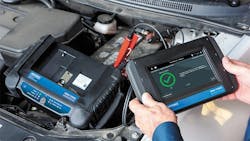U.S. market share for start-stop systems is growing quickly. Estimates call for start-stop systems to be installed on 40% of new vehicles sold in the U.S. in 2020, up from less than 2% today. There are currently an estimated 4.9 to 5.2 million vehicles in operation equipped with start-stop systems in the U.S., according to Dale Gospodarek of Johnson Controls Inc.
“In 2017, start-stop systems are still relatively nascent in the U.S. aftermarket, but they are becoming increasingly more popular,” says Gospodarek, who is vice president of marketing and strategy for aftermarket U.S. and Canada. He notes that in 2016 alone there were almost seven times more start-stop vehicles produced than all types of hybrid, plug-in and electric vehicles combined.
Start-stop technology turns off the engine when the vehicle stops and restarts it when the brake is released. Jim O’Hara, vice president of marketing for Clore Automotive Inc., says the technology is relatively easy to master and the equipment investment is relatively low. Shops need battery testing equipment optimized for start-stop absorbent glass mat (AGM) and enhanced flooded batteries (EFB) and appropriate charging equipment. “Positioning themselves to serve this market enables shops to capture the additional sales that often are associated with battery/starting/charging system assessment, such as replacement battery, rotating electric and related cable sales,” says O’Hara.
Gospodarek says the opportunities that start-stop systems offer are much like any of the other new systems, such as PCM (powertrain control module) controlled engine performance. “Training and marketing are the keys to being able to service these vehicles. Shops that invest in training their staff on start-stop systems and then market their shop’s ability to service these systems will be the ones that see the most opportunities.”
Mike Dziadus, senior account manager at Midtronics Inc., says start-stop systems are already a part of the target market for aftermarket providers. “Start-stop systems require a healthy battery in proper working condition to function at peak effectiveness, offering aftermarket service providers the opportunity to improve customer service and satisfaction by providing preventative maintenance battery testing.”
To fully assess battery condition in start-stop vehicles, shops must have the correct tools to test batteries for reserve capacity, according to Dziadus. “Aftermarket providers need the correct tools to test batteries for their specific failure modes. Start-stop batteries rely as much on their reserve capacity (RC) as they do their cranking ability, so make sure your testing tool offers the ability to assess RC.”
John Munsell, battery product specialist for General Motor Corp.’s ACDelco brand, says the key for shops will be training to diagnose and repair start-stop vehicles. “It is also important to understand from a GM perspective that since an AGM battery or batteries are used in the vehicle that they must be replaced with AGM batteries in the event of a failure.”Munsell says that for vehicles manufactured by General Motors, “we neither recommend, nor endorse replacing an AGM battery with an EFB battery. An EFB battery will have a different charge profile than an AGM battery, which will lead to premature failure of the battery.”
Gospodarek notes that the majority of batteries used today in start-stop applications are AGM technology. “It is critically important to replace a worn-out AGM battery with a new AGM battery. AGM batteries are the most robust batteries you can use for the high cycle demand of start-stop systems.” Because AGM batteries come in similar group size and CCA (cold cranking amps) performance ratings as standard flooded batteries, telling them apart can be challenging. “Always check the OE battery label, or consult the owner’s manual to confirm that the vehicle is equipped with an AGM battery, and be sure to specify AGM technology when ordering the replacement battery from your parts supplier,” says Gospodarek.
View start-stop as a system
Start-stop systems are typically more complex than traditional starting systems, according to O’Hara. They often involve more than one battery and a mixture of battery types, and they can incorporate battery management systems that allow for load management between the various batteries.
“It is important to view start-stop as a system, assessing each component in relation to the overall system, as opposed to focusing on the component separate from the system in which it operates. For instance, on two battery systems, it is critical to assess the health of both batteries when troubleshooting a system problem, not just the primary starting battery,” says O’Hara.
Munsell says AGM batteries require special care when charged offline. “This special care is to make sure that the charger has an AGM switch that will supply lower voltage to the battery during the charging process. This lower voltage is required due to the charge receptivity of AGM batteries. The maximum charging voltage for an AGM battery at 80 degrees Fahrenheit is between 14.4 volts and 14.6 volts. If the ambient temperature is higher than that, charging voltage goes down,” says Munsell.
Gospodarek notes that current start-stop systems are considered “low voltage” (below the 60 volt threshold) systems and present no particular challenges in servicing them, aside from having the proper type of training and testing equipment for batteries and electrical/electronic systems.
“Battery testers and charging/conditioning equipment are different for AGM batteries, so shops need to be up-to-date on this equipment. In addition, start-stop vehicles manufactured by German automakers require a battery management system reset using special equipment. Most other automakers do not require this reset or any special equipment to replace the AGM battery,” he says.
Johnson Controls predicts start-stop systems will find their way into more than 40% of new vehicles sold in the U.S. and will number over 40 million registered vehicles by 2020. Automakers will continue to make refinements to the systems to improve the consumer experience. Says Gospodarek, “In the coming years, you will begin to see a few new vehicles with dual batteries for more energy availability to power electrical accessories as well as power new autonomous driving features in the vehicles, such as autonomous emergency braking, self-steering and auto-park. These dual battery setups will be either AGM+AGM or AGM+Li-ion.” ■
Service review: Is your shop start-stop ready?
Start-stop systems have been in use in Europe for quite some time, according to Will Sampson, vice president and business leader in Midtronics’ transportation division.
“With an EU headquarters in the Netherlands since 1990, we’ve gained a unique perspective and extensive base of knowledge and experience with start-stop technologies from the outset,” says Sampson. “We’ve leveraged that early exposure, along with years of proactive development work, to create tools with the ability to analyze and service the batteries and electrical systems in start-stop vehicles.”
Sampson predicts start-stop will continue to grow in number of vehicle models in the U.S. with corresponding advancements in battery design based on battery manufacturer innovation to find the best start-stop solution between AGM and EFB batteries.“Yesterday’s battery and electrical service environment was fairly simple: 12-volt lead-acid battery, alternator and starter. That’s all changing,” he says.
“From micro-hybrid and start-stop to multiple versions of hybrid/electric vehicles, the future of battery and electrical system diagnostics has changed forever.”
He offers some areas to consider when sizing up a shop’s readiness for start-stop systems.
• New batteries, systems and components will require improved technology for accurate diagnostics.
• Battery locations will differ by vehicle make and model and may be difficult to find or access.
• Battery chemistries, type and construction will vary greatly, creating the need for service tools that identify the vehicle, battery and correct diagnostic routine.
• A growing assortment of vehicles means service tools will need to evolve and expand with the market.
• More vehicles with advanced battery management systems means service tools need to talk to the system and analyze the battery/electrical system at the same time.
• More choices in modern vehicles means that selecting the correct battery size, chemistry and type during replacement is more critical for vehicle performance, customer satisfaction, and to keep warranty costs down.
• The role of the battery is changing from starting a few times a day to multiple times per trip while handling the load for an expanding array of electronics, which drives the need for improved measurements and diagnostics in the shop.
About the Author

Ann Neal
Ann Neal is a former senior editor at Modern Tire Dealer.
